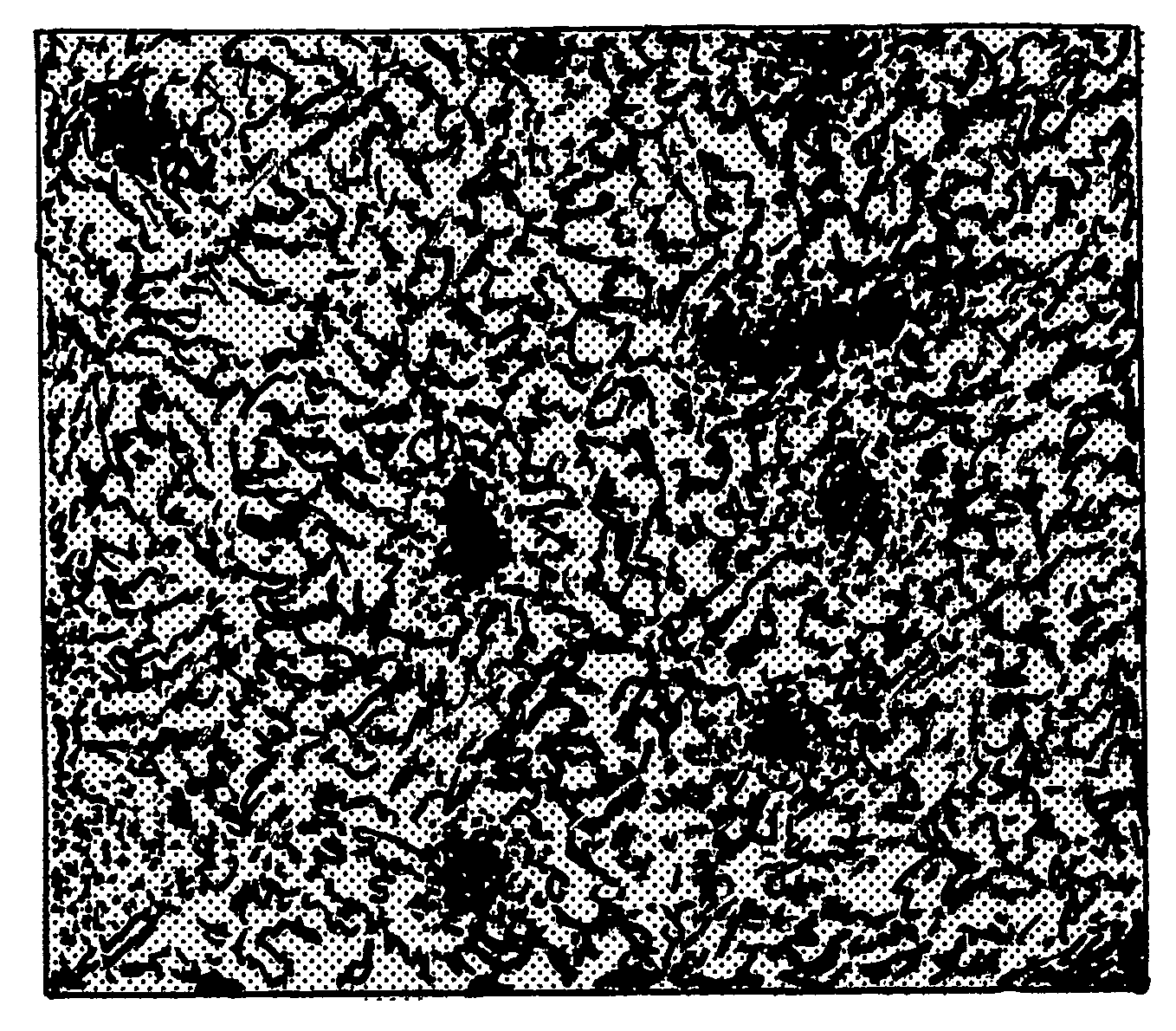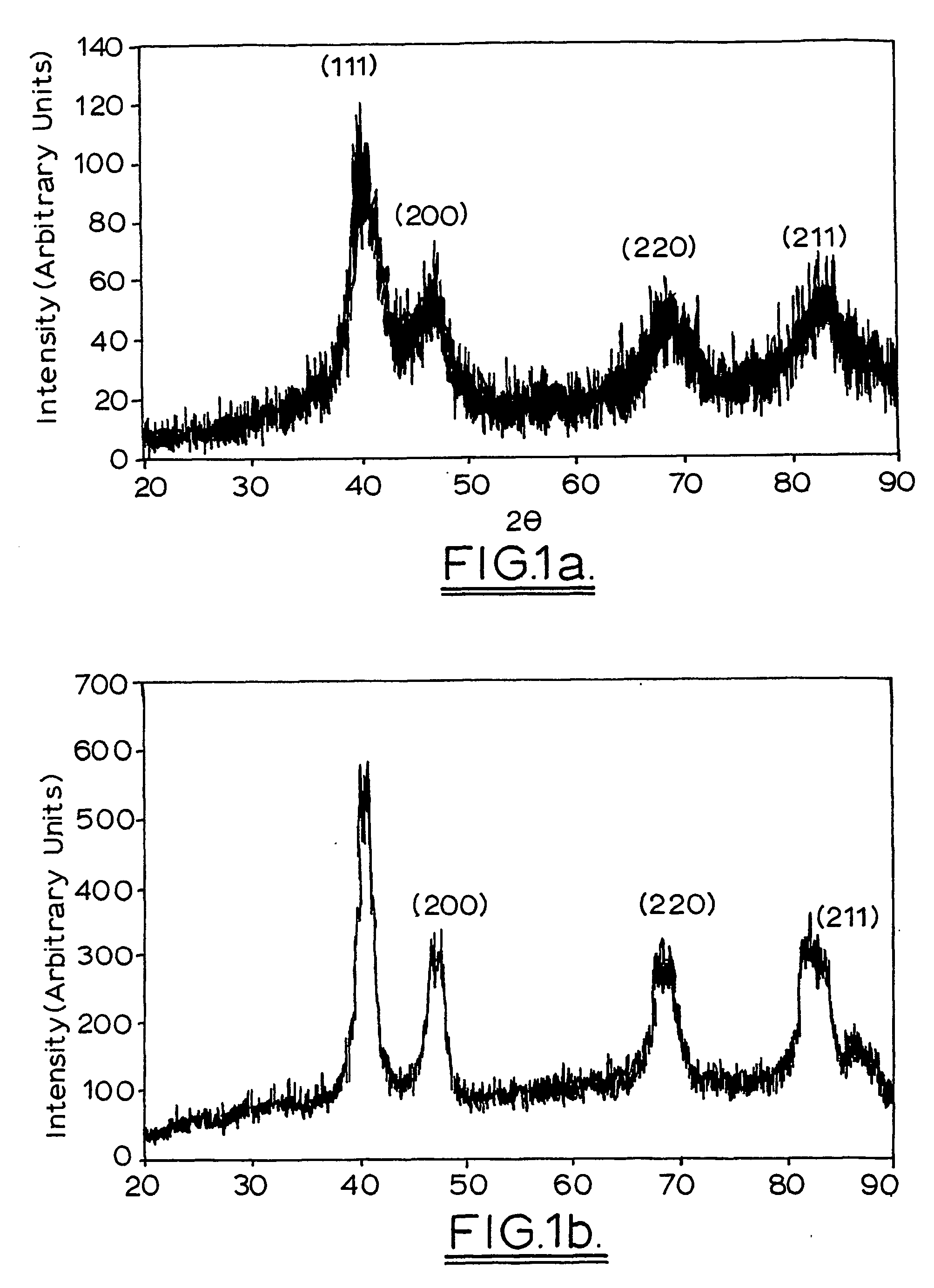Magnetic nanoparticles
a nanoparticle and nanoparticle technology, applied in the field of magnetic nanoparticles, can solve the problems of poor magnetic properties, low signal to noise ratio in recorded information, and disordered fcc phase of deposited copt alloy films, and achieve high magnetic coercivity, improve the effect of magnetic coercivity and reduce the temperature of fct phase formation
- Summary
- Abstract
- Description
- Claims
- Application Information
AI Technical Summary
Benefits of technology
Problems solved by technology
Method used
Image
Examples
example 1
Synthesis of CoPt Magnetic Alloy Nanoparticles:
[0036] Sodium tetrachloroplatinate tetrahydrate Na2PtCl4.4H2O (99.99%), sodium borohydride NaBH4 (98%), sodium bis(2-ethylhexyl) sulfosuccinate commonly known as AOT (99%) and cobalt chloride hexahydrate, n-heptane (99%) and ethanol (95%) were the ingradients used for the above mentioned synthesis.
[0037] The first step is to prepare reverse micellar solutions of cobalt and platinum ions of the desired concentration and water content w. A concentrated aqueous solution of cobalt chloride and sodium tetrachloroplatinate was solubilized in the solution of NaAOT in Heptane previously prepared, to the desired concentration of the ionic salts. The proportions of cobalt and platinum salts are based on the final alloy composition sought. For example, to prepare a micellar solution of Co:Pt with a 1:1 proportionality, the starting concentration of Co2+ and of Pt2+ should be 0.002M in a 100 mL flask with w=8. Cobalt chloride hexahydrate (47.6 m...
example 2
Synthesis of FePt Magnetic Alloy Nanoparticles
[0048] Sodium tetrachloroplatinate tetrahydrate Na2PtCl4.4H2O (99.99%), sodium borohydride NaBH4 (98%), sodium bis(2-ethylhexyl) sulfosuccinate commonly known as AOT (99%) and Iron chloride hexahydrate FeCl2.6H2O, n-heptane (99%) and ethanol (96%) were the ingredients used for the synthesis.
[0049] A reverse micellar solution containing Fe3+ and Pt2+ with overall concentrations, for each metal ion of 0.002 M in 100 ml and a water content of W=8 was prepared as follows:
[0050] Iron chloride hexahydrate (54.05 mg) together with Sodium tetrachloroplatinate in powder form were weighed into a 100 ml flask. Doubly distilled water (2.88 ml) was added to form a small concentrated solution of Fe3+ and Pt2+ ions in water. Then a previously prepared solution of AOT in heptane was added to the concentrated solution of Fe3+ and Pt2+ ions to fill to the mark. This suspension was homogenized by ultrasonication to form a clear golden brown solution. T...
example 3
Synthesis of NiPt Magnetic Alloy Nanoparticles
[0051] Sodium tetrachloroplatinate tetrahydrate Na2PtCl4.4H2O (99.99%), sodium borohydride NaBH4 (98%), sodium bis(2-ethylhexyl) sulfosuccinate commonly known as AOT (99%) and Nickel chloride hexahydrate NiCl2.6H2O, n-heptane (99%) and ethanol (96%) were the ingredients used for the synthesis.
[0052] Nickel chloride hexahydrate (54.05 mg) together with Sodium tetrachloroplatinate in powder form were weighed into a 100 ml flask. Doubly distilled water (2.88 ml) was added to form a small concentrated solution of Ni2+ and Pt2+ ions in water. Then a previously prepared solution of AOT in heptane was added to the concentrated solution of Ni2+ and Pt2+ ions to fill to the mark. This suspension was homogenized by ultrasonication to form a clear golden brown solution. The Ni2+ and Pt2+ ions in solution were reduced into the metallic state with a reverse micellar solution of an equivalent amount of sodium borohydride. This reverse micellar solu...
PUM
| Property | Measurement | Unit |
|---|---|---|
| particle size | aaaaa | aaaaa |
| temperature | aaaaa | aaaaa |
| particle size | aaaaa | aaaaa |
Abstract
Description
Claims
Application Information
 Login to View More
Login to View More - R&D
- Intellectual Property
- Life Sciences
- Materials
- Tech Scout
- Unparalleled Data Quality
- Higher Quality Content
- 60% Fewer Hallucinations
Browse by: Latest US Patents, China's latest patents, Technical Efficacy Thesaurus, Application Domain, Technology Topic, Popular Technical Reports.
© 2025 PatSnap. All rights reserved.Legal|Privacy policy|Modern Slavery Act Transparency Statement|Sitemap|About US| Contact US: help@patsnap.com



